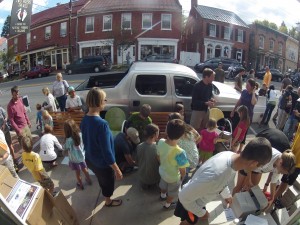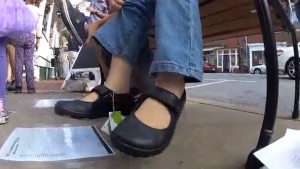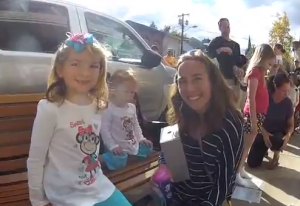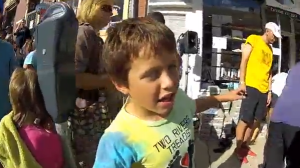Check out our video from the 2103 Givaway!
Check out Jay’s and my article in Running Times on children’s shoes
Here is Competitor Magazine Sept 2014 story
My favorite event of the year at our small natural running and walking shoe store in Shepherdstown, West Virginia is the Two Rivers Treads and Vivobarefoot Free Kids Shoe Giveaway. In 2013 Two Rivers Treads had its 4th annual kids shoe giveaway. We personally matched a contribution from Vivobarefoot and gave out close to 300 pairs of free shoes to local children. Yes, free — and not based on a family’s income level. All were welcomed.
 It was a beautiful day, filled with happy families and healthy feet, as this video (watch above) made by Cody Marsh shows. Yet in talking with parents and kids, it was clear that the “free” part was only part of the larger picture. Parents can buy shoes for 10 dollars at Walmart.
It was a beautiful day, filled with happy families and healthy feet, as this video (watch above) made by Cody Marsh shows. Yet in talking with parents and kids, it was clear that the “free” part was only part of the larger picture. Parents can buy shoes for 10 dollars at Walmart.
At long last, many parents are increasingly come to the realization that what is on his their child’s foot for 10 or more hours a day is important for his or her development. No other accessory in their wardrobe gets this much play and effects their movement and anatomy. Kids simply love the flat-sole Vivobarefoot shoes and how their feet feel in them.
The ultimate compliment is when a child approaches me, points to the shoes, and says with a huge smile “I got my Dr. Mark shoes on”.
(Some parents have accused me of unduly influencing their children who now refuse to put on other shoes or always want to be barefoot. Sorry for this.)
Last week at our Runner’s Club at Shepherdstown Elementary half of the children voluntarily left their shoes with their book bags and ran for 40 minutes barefoot, some even on gravel. Their feet are adapted to this and we should allow them to stay this way.
We are all born barefoot and if lucky we are allowed to run, jump, and bound in our bare feet as children. This is how I developed my own magic human spring (elastic recoil) when I run and which starts at the foot.
Like many, I began to run in cushioned shoes (spring getting smaller), and then I got hurt and was told to run in a supportive shoe (spring getting smaller), and then got hurt again and advised to run in the supportive shoe and orthotics (spring getting smaller).
I see adults in my hospital clinic now who cannot run (spring gone).
When a parent has a question regarding the health needs of their children, they often look to advice of medical professionals. As a Family Practice physician, I consider prevention and overall health as important as disease treatment. Unfortunately, when it comes to the science on feet, footwear, overuse injuries, structural development, and even nutrition, our education is wanting.
We often defer to what is the conventional wisdom of the day. “Of course a foot needs cushion and support” we reflexively think in the same paradigm of “to prevent getting fat you should eat low fat.” We are slowly discovering that much conventional wisdom is not grounded in science, and the results are showing.
The American Podiatric Medical Association’s position paper on children’s shoes says, “Select a shoe that’s rigid in the middle. Does your shoe twist? Your shoe should never twist in the middle.” Right below that in fine print you find, “this does not apply to toddlers shoes. For toddlers, shoes should be as flexible as possible.” To us, this raises the question, “So at what time does a toddler become a child and we restrict their feet?”
Leading researchers in gait and running Dr. Irene Davis and Dr. Daniel Lieberman have been giving us the basic science of how we run in barefoot and shod conditions and how footwear affects this, even at a young age. This has shifted the conventional wisdom of the proper adult shoe but their research is even more relevant for children, as childhood is the time when the neuromuscular pathways are forming.
Were you to read Dr. Davis’s paper in the Fall 2011 American Medical Athletic Association Journal you’d find specifics of loading rates, proprioception, the effects of cushioning and more — but for a thinking parent, this is a good summary: “No one would argue with the fact that a strong foot is more likely to be a healthy foot that is more resistant to injury. It has been shown that when individuals remove their shoes and go barefoot, or run with shoes without any arch or rearfoot support, their feet become stronger.”
In 2011, Caleb Wegener conducted a review of the effect of shoes on children’s gait, reported in the Journal of Foot and Ankle Research, and concluded: “Shoes affect the gait of children. With shoes, children walk faster by taking longer steps with greater ankle and knee motion and increased tibialis anterior activity. Shoes reduce foot motion and increase the support phases of the gait cycle. During running, shoes reduce swing phase leg speed, attenuate some shock and encourage a rearfoot strike pattern. The long-term effect of these changes on growth and development are currently unknown. The impact of footwear on gait should be considered when assessing the pediatric patient and evaluating the effect of shoe or in-shoe interventions.”
As long ago as 1991, a review of children’s shoes and gait in the journal Pediatrics by Lynn Staheli outlined key factors that affect children’s feet:
– Optimum foot development occurs in the barefoot environment.
– Stiff and compressive footwear may cause deformity, weakness, and loss of mobility.
– The term “corrective shoes” is a misnomer.
– Shoe selection for children should be based on the barefoot model.
 Way back in 1947, a fascinating survey of over 5,000 shod vs, barefoot men and women in China and India concluded: “People who have never worn shoes acquire very few foot defects, most of which are painless and non-debilitating. The range of their foot motions are remarkably great, allowing for full foot activity. Shoes are not necessary for healthy feet and are the cause of most foot troubles. Children should not be encouraged to walk prematurely and should not wear any foot gear until absolutely necessary. Foot gear is the greatest enemy of the human foot.”
Way back in 1947, a fascinating survey of over 5,000 shod vs, barefoot men and women in China and India concluded: “People who have never worn shoes acquire very few foot defects, most of which are painless and non-debilitating. The range of their foot motions are remarkably great, allowing for full foot activity. Shoes are not necessary for healthy feet and are the cause of most foot troubles. Children should not be encouraged to walk prematurely and should not wear any foot gear until absolutely necessary. Foot gear is the greatest enemy of the human foot.”
Finally, a seminal paper in 1905 by P Hoffman published in the American Journal Of Orthopedic Surgery concluded: “…feet all develop the same up until the time of wearing shoes, after which progressive characteristic deformation and inhibition of function ensue. The children of shoe wearers inherit the same foot type as barefoot races, and this type is changed only so far as foot wear modifies it.”
It follows from all of these studies that the best shoes for our children are ones that are closest to no shoes, neither changing the shape of the foot nor altering how the foot works in action. Children of Shepherdstown were to told enjoy the shoes with only this one imple rule we gave them on Sunday: “You must wear them out with play in the original Playstation– not indoors, but in the backyard”


